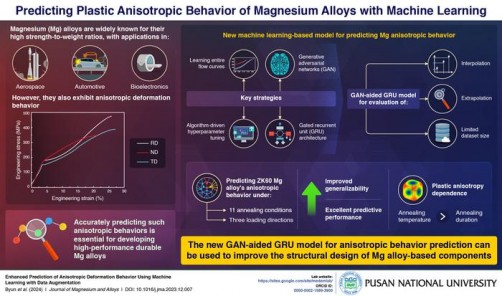Newswise — Magnesium (Mg) alloys have been popularly used for designing aerospace and automotive parts owing to their high strength-to-weight ratio. Their biocompatibility and low density also make these alloys ideal for use in biomedical and electronic equipment. However, Mg alloys are known to exhibit plastic anisotropic behavior. In other words, their mechanical properties vary depending on the direction of the applied load. To ensure that the performance of these Mg alloys is unaffected by this anisotropic behavior, a better understanding of the anisotropic deformations and the development of models for their analysis is needed.
According to Metal Design & Manufacturing (MEDEM) Lab led by Associate Professor Taekyung Lee from Pusan National University, Republic of Korea, machine learning (ML) might hold answers to this prediction problem. In their recent breakthrough, the team proposed a novel approach called “Generative adversarial networks (GAN)-aided gated recurrent unit (GRU).” The model holds powerful data analysis abilities to accurately predict the plastic anisotropic properties of wrought Mg alloys. Their work was made available online in the Journal of Magnesium and Alloys on 16 January 2024.
“In terms of the accuracy of ML predictions from the viewpoint of data science, we realized that there was room for improvement. So, unlike the previously reported methods of prediction, we developed an ML model with data augmentation to attain accuracy, as well as generalizability with respect to various loading modes. This eventually opened ways of integration with a finite-element analysis to extract precise stress estimation of products made from metal alloys with significant plastic anisotropy,” says Prof. Lee, describing the core idea behind their novel model.
To build a model with enhanced accuracy, the team combined the entire flow curves, GAN, algorithm-driven hyperparameter tuning, and GRU architecture, which are some of the key strategies used in data science. This new approach facilitates the learning of entire flow-curve data rather than being limited to train on summarized mechanical properties, like many previous models.
To test the reliability of the GAN-aided GRU model, the team extensively evaluated it under predictive scenarios, ranging from extrapolation, interpolation, and robustness, with datasets of limited size. When put to the test, the model estimated the anisotropic behavior of ZK60 Mg alloys for three loading directions and under 11 annealing conditions.
With these experiments, the team discovered that their model showed significantly better robustness and generalizability than other models designed to perform similar tasks. This superior performance is mainly attributed to GAN-aided data augmentation and supported by the excellent extrapolation ability of GRU architecture and optimization of hyperparameters—parameters whose values are used to control the learning process.
Therefore, this study takes predictive modeling beyond artificial neural networks. It successfully demonstrates the ability of ML-based models for estimating the anisotropic deformation behaviors of wrought Mg alloys. “The overall performance and lifespan of components made from Mg alloy are largely dependent on the plastic anisotropic behavior which makes forecasting and management of deformations a vital part of material design. We believe that the model will assist in the design and manufacturing of metal products for various applications,” concludes Prof. Lee on an optimistic note.
Let us hope that this groundbreaking study paves the way towards many more innovations in the fields of artificial intelligence and machine learning as well as computational materials science!
***
Reference
DOI: https://doi.org/10.1016/j.jma.2023.12.007
Authors: Sujeong Byun1, Jinyeong Yu1, Seho Cheon1, Seong Ho Lee1, Sung Hyuk Park2, and Taekyung Lee1,*
Author affiliations: 1School of Mechanical Engineering, Pusan National University
2School of Materials Science and Engineering, Kyungpook National University
Lab website address: https://sites.google.com/site/medemlab/
ORCID ID: 0000-0002-1589-3900
About the Institute
Pusan National University, located in Busan, South Korea, was founded in 1946 and is now the No. 1 national university of South Korea in research and educational competency. The multi-campus university also has other smaller campuses in Yangsan, Miryang, and Ami. The university prides itself on the principles of truth, freedom, and service, and has approximately 30,000 students, 1200 professors, and 750 faculty members. The university is composed of 14 colleges (schools) and one independent division, with 103 departments in all.
Website: https://www.pusan.ac.kr/eng/Main.do
About the author
Prof. Taekyung Lee is an Associate Professor at the School of Mechanical Engineering at Pusan National University, Korea. His group, Metal Design & Manufacturing (MEDEM) Lab, is developing advanced metal-forming processes. MEDEM studies the electropulsing treatment, additive manufacturing process, and severe plastic deformation process. MEDEM is also interested in the optimization of processing parameters based on physics, machine learning, and microstructure-mechanical analysis. Prof. Lee earned his Ph.D. at POSTECH, Korea in 2014 and completed the postdoctoral training at Northwestern University, USA. Before coming to Pusan National University, he worked at Kumamoto University, Japan, for two years as an assistant professor.
